Prosodic Transfer in Contact Varieties: Vocative Calls in Metropolitan and Basaá-Cameroonian French
Abstract
1. Introduction
2. Some Background on the Formation of Vocative Calls
2.1. Basaá Vocative Calls
- (1)
- à ʧá↓á!voc Bitjaa‘Bitjaa!’ (Colloquial form)
- (2)
- à sáŋgó βíʧá↓ávoc Mister Bitjaa‘Mr. Bitjaa!’ (Polite form)
- Group 1: nouns starting with a syllabic prefix and whose first vowel underlyingly carries a low tone → the vocative marker surfaces as {á} and the name loses its noun class prefix. No changes are observed in the tones of the lexical root.
- Group 2: nouns starting with a syllabic prefix and whose first vowel underlyingly carries a high tone → the vocative marker surfaces as {à-} and the name loses its noun class prefix. The tones of the lexical root remain unchanged.
- Group 3: nouns without a noun class prefix and whose first vowel underlyingly carries a high tone → the vocative marker surfaces as {à-} and the tones of the lexical root are unaffected.
- Group 4: nouns without a noun class prefix and whose first vowel underlyingly carries a low tone → the vocative marker surfaces as {à-} and high tone surfaces on the lexical root, either forming a falling tone on the first vowel of the noun or leading to a downstep on a following high tone.
2.2. Metropolitan French Vocative Calls
- (3)
- Chanting contour (Fagyal 1997, p. 81)A, the aunt, is taking Joanna, her niece, out. She cannot see her, so she calls sweetly:A: Joanna!
- (4)
- a. Ṁarthe [maχt] → Ma-arthe! [ma.aχt]b. Yann [jan] → Ya-an! [ja.an]c. Louise [lwiz] → Lou-ise! [lu.wiz]
2.3. Basaá-Cameroonian French Vocative Calls
- (5)
- Màrínà (L H L)
- (6)
- Màgdàlénà (L L H L)
- (7)
- Yânn (HL)
- (8)
- Grégórŷ (H H HL)
- (9)
- [káásà] < Kaiser (Ger), “emperor”
- (10)
- [màlêɾ] < Lehrer (Ger), “teacher”
- (11)
- [kìŋgê] < King (Eng)
- (12)
- [mésà] < Messe (Fr), “mass”
3. Materials and Methods
3.1. Stimuli and Procedure
- (13)
- Vous entrez dans une pièce et vous voyez que votre enfant a cassé votre vase préféré. Vous l’appelez: ...‘You enter a room and you see that your child has broken your favorite vase. You call them: ...’
3.2. Participants
3.3. Data Analysis
3.3.1. Data Annotation
3.3.2. Tonal Landmark Measures
- Initial Tone (IN): the F0 at the onset of the contour;
- Rise Onset (RO): RO corresponds to the F0 at the onset of the rise to the first (and sometimes only) peak in the contour. It was only measured in three and four-syllabic words. RO and IN coincided in 1- and 2-syllabic words.
- High 1 (H1): In the chanting melody, H1 was the F0 maximum of the first peak in the contour, while in rising-falling contours it was the only peak. Similarly, in rising contours there was also only one peak (H) found at the end of the word.
- Low (L): in the chanting melody, L was the F0 minimum in the dip in the contour (between the two H tones). In the rising-falling melody, it was the lowest point reached at the end of the contour.
- High 2 (H2): in the chanting melody, the F0 maximum at the end of the contour.
3.3.3. Additional Measurements
- F0 range, measured here as the difference between the F0 maximum and F0 minimum for a given name (Cosmides 1983, we thus focus on “span” in the sense of Ladd 2008)
- Duration (in seconds) for the entire name,
- Root mean square amplitude of the whole name. Prior to analysis, the RMS was log transformed as it was positively skewed.
3.3.4. Statistical Analysis
4. Results
4.1. Calling Melody Frequency
4.1.1. Metropolitan French
4.1.2. Basaá-Cameroonian French
4.2. F0 Scaling of Tonal Landmarks
4.2.1. Metropolitan French
4.2.2. Basaá-Cameroonian French
4.3. F0 Range of Tonal Landmarks
4.3.1. Metropolitan French
4.3.2. Basaá-Cameroonian French
4.3.3. Cross-Dialectal Comparison
4.4. RMS Amplitude
4.4.1. Metropolitan French
4.4.2. Basaá-Cameroonian French
4.4.3. Cross-Dialectal Comparison
4.5. Word Duration
4.5.1. Metropolitan French
4.5.2. Basaá-Cameroonian French
4.5.3. Cross-Dialectal Comparison
5. Discussion and Conclusions
Author Contributions
Funding
Institutional Review Board Statement
Informed Consent Statement
Data Availability Statement
Acknowledgments
Conflicts of Interest
| 1 | With its highly heterogenous population and over 250 local languages from the 4 major African language families, Cameroon is often described as ‘Africa in miniature’. Although a few of the local languages serve as languages of major communication at the regional level, none of them dominates at the national level (Tabi Menga 1999). French was first introduced in 1916 and was imposed as the only language of education in the part of Cameroon under French rule. It has since acquired vehicular language status and is regularly used for inter-group communication (Mendo Ze 1999). For over 80% of the Cameroonian population, i.e., people living in present-day Francophone regions of Cameroon, it is still the main language of education and administration (Onguene Essono 1999, 2003). Together with English, which has been present in the country since around 1840 and is still dominant in the Western regions of Cameroon, French has remained one of the two official languages, even after the country gained its independence in 1960 (Mendo Ze 1999). |
| 2 | We are extremely grateful to Emmanuel-Moselly Makasso (p.c.) for drawing our attention to this fact and for providing us with the tonal specifications for the proper names used in the experiment. Note that we cannot presently state whether speakers of Cameroonian French with other L1s will differ from our present speakers, as Cameroonian French is certainly the result of the contact of French with many typologically unrelated languages (tone languages and others) and not only Basaá. Further research will inform us of the specificities of Basaá-Cameroonian French speakers as compared to other speakers of Cameroonian French. |
| 3 | Several realizations of the phoneme /r/ were observed. For more detail on this point, the interested reader is referred to Hamlaoui et al. (2020). |
| 4 | A limit of the present design is that it does not distinguish between polite and informal calls, a distinction that has been described to be relevant in Basaá. Rather, the calls elicited within the present study all fall within the informal type. A design of the type found in Borras-Comes et al. (2015) could be used in the future to determine whether this distinction is somehow transferred onto Basaá-Cameroonian French. This could also allow determining whether Basaá-Cameroonian French speakers have distinct means of expressing the type of speaker-hearer connivence that typically licenses the use of the vocative chant in Metropolitan French (Ladd 2008). |
| 5 | As pointed out by an anonymous reviewer, regional varieties of French also vary in pronunciation, making the label Northern Metropolitan French (NMF, Carignan 2013; Nicholas et al. 2019) more appropriate for the variety of European French considered here. On the segmental level, all speakers exhibited a Standard French pronunciation, consistent with NMF. Although there were audible differences in the way some of our speakers realized calls (e.g., in terms of the intensity of positive/negative emotion associated with our discourse contexts, or assumed distance between caller and callee), none of these differences could be attributed to a difference in geographic origin or the influence of another language. Varieties of Northern French have been described as undergoing a process of accent levelling or phonological uniformization, by which regionally localized features tend to disappear. This is particularly true of urban varieties, with differences across urban centers (Boughton 2005). The interested reader is also referred to Armstrong and Pooley (2010). A larger and more controlled sample of speakers from different regions of France would be needed to account for possible cross-dialectal differences in vocative calls within Metropolitan French. |
| 6 | As noted in previous studies (see for instance Mennen et al. 2014), in European countries it is generally difficult to find monolingual speakers in the strictest sense of the word, as people have usually received secondary instruction in at least one foreign language. As pointed out by an anonymous reviewer, it might be more accurate to consider our NMF speakers as having French as their native and dominant language, rather than as monolingual speakers. The same applies to our group of Cameroonian French speakers, who have also received secondary instruction in at least one foreign language, typically English. We expect the potential transfer effect from these other languages to be negligible. |
| 7 | The meaning associated with the rising contour was that of a question of the type ”Can you hear me?”, “Are you there?”. |
References
- Altenberg, Evelyn P., and Carole T. Ferrand. 2006. Fundamental frequency in monolingual English, bilingual English-Russian, and bilingual English-Cantonese young adult women. Journal of Voice 20: 89–96. [Google Scholar] [CrossRef] [PubMed]
- Armstrong, Nigel, and Tim Pooley. 2010. Social and Linguistic Change in European French. Chapter Accents and levelling in France, Belgium and Switzerland. Berlin: Springer, pp. 100–49. [Google Scholar]
- Arvaniti, Amalia, Marzena Żygis, and Marek Jaskuɫa. 2016. The phonetics and phonology of the Polish calling melodies. Phonetica 73: 338–61. [Google Scholar] [CrossRef]
- Avanzi, Mathieu, and Guri Bordal Steien. 2016. La prosodie du français en contact. Langages 202: 5–12. [Google Scholar] [CrossRef]
- Bardovi-Harlig, Kathleen. 2002. Handbook of Applied Linguistics. Chapter Pragmatics and Second Language Acquisition. Oxford: Oxford University Press, pp. 182–92. [Google Scholar]
- Bates, Douglas, Martin Maechler, Ben Bolker, Steven Walker, Rune Haubo Bojesen Christensen, Henrik Singmann, Bin Dai, Fabian Scheipl, Gabor Grothendieck, Peter Green, and et al. 2020. Lme4 Package Version 1.1-23. Available online: https://cran.r-project.org/web/packages/lme4/index.html (accessed on 10 October 2022).
- Bitjaa Kody, Zachée Denis. 1990. Le Système Verbal du Basaa. Ph. D. thesis, Université de Yaoundé, Yaoundé, Cameroon. [Google Scholar]
- Bitjaa Kody, Zachée Denis, and Ngessimo Mutaka. 1997. Le vocatif en bantu A. Journal of West African Languages 26: 55–69. [Google Scholar]
- Boersma, Paul, and David Weenink. 2016. Praat Doing Phonetics by Computer. Software. Available online: https://www.fon.hum.uva.nl/praat/ (accessed on 10 October 2022).
- Bordal, Guri. 2013. Le français centrafricain: Un français à tons lexicaux. Revue française de linguistique appliquée XVIII: 91–102. [Google Scholar]
- Bordal, Guri. 2015. Traces of the lexical tone system of Sango in Central African French. In Prosody and Language in Contact. Berlin: Springer, pp. 29–49. [Google Scholar]
- Bordal, Guri, and Chantal Lyche. 2012. La variation prosodique régionale en français. Chapter Regard sur la prosodie du français d’Afrique à la lumière de la L1 des locuteurs. Bruxelles: DeBoeck. [Google Scholar]
- Borràs-Comes, Joan, Rafèu Sichel-Bazin, and Pilar Prieto. 2015. Vocative intonation preferences are sensitive to politeness factors. Language and Speech 58: 68–83. [Google Scholar] [CrossRef] [PubMed]
- Bot Ba Njock, Henri-Marcel. 1964. Les tons en basaa. Journal of African Languages 3: 252–59. [Google Scholar]
- Boughton, Zoë. 2005. Accent levelling and accent localisation in French: Comparing Nancy and Rennes. French Language Studies 15: 235–56. [Google Scholar] [CrossRef]
- Braunmüller, Kurt, and Christoph Gabriel. 2012. Multilingual Individuals and Multilingual Societies. Amsterdam: John Benjamins. [Google Scholar]
- Broselow, Ellen. 2000. Stress, epenthesis, and segment transformation in Selayarese loans. In Proceedings of the Twenty-Fifth Annual Meeting of the Berkeley Linguistics Society 1999: General Session and Parasession on Loan Word Phenomena. Berkeley: Berkeley Linguistics Society, pp. 311–25. [Google Scholar]
- Brown, H. Douglas. 2000. Principles of Language Learning and Teaching. New York: Addison Wesley Longman. [Google Scholar]
- Brown, Penelope, and Stephen C. Levinson. 1987. Politeness: Some Universals in Language Usage. Cambridge: Cambridge University Press. [Google Scholar]
- Brown, Roger, and Albert Gilman. 1960. The pronouns of power and solidarity. In Style in Language. Edited by Thomas. A. Sebeok Sebeok. Cambridge: MIT Press, pp. 253–76. [Google Scholar]
- Carignan, Christopher. 2013. When Nasal Is More Than Nasal: The Oral Articulation of Nasal Vowels in Two Dialects of French. Ph. D. thesis, University of Illinois at Urbana, Champaign, IL, USA. [Google Scholar]
- Chen, Matthew Y. 2000. Tone Sandhi: Patterns across Chinese Dialects. Cambridge: Cambridge University Press. [Google Scholar]
- Colantoni, Laura. 2011. Intonational Phrasing in Romance and Germanic: Cross-Linguistic and Bilingual Studies (Hamburg Studies on Multilingualism 10). Chapter Broad-Focus Declaratives in Argentine Spanish Contact and Non-Contact Varieties. Amsterdam: John Benjamins, pp. 183–212. [Google Scholar]
- Colantoni, Laura, and Jorge Gurlekian. 2004. Convergence and intonation: Historical evidence from Buenos Aires Spanish. Bilingualism: Language and Cognition 7: 107–19. [Google Scholar] [CrossRef]
- Cosmides, Leda. 1983. Invariances in the acoustic expression of emotion in speech. Journal of Experimental Psychology. Human Perception and Performance 9: 864–81. [Google Scholar] [CrossRef]
- Delais-Roussarie, Elisabeth, Mathieu Avanzi, and Sophie Herment. 2015. Prosody and Language in Contact: L2 Acquisition, Attrition and Languages in Multilingual Situations. Berlin: Springer. [Google Scholar]
- Delais-Roussarie, Elisabeth, Brechtje Post, Mathieu Avanzi, Carolin Buthke, Albert Di Cristo, Ingo Feldhausen, Sun-Ah Jun, Philippe Martin, Trudel Meisenburg, Annie Rialland, and et al. 2015. Intonational phonology of French: Developing a ToBI system for French. In Intonation in Romance. Edited by Sonia Frota and Pilar Prieto. Oxford: Oxford University Press. [Google Scholar]
- Delattre, Pierre. 1966. Les dix intonations de base du français. The French Review 40: 1–14. [Google Scholar]
- Dell, François. 1984. L’accentuation dans les phrases en français. In La Forme Sonore du Langage: Structure des Représentations en Phonologie. Edited by François Dell and Jean-Roger Vergnaud. Paris: Hermann. [Google Scholar]
- Di Cristo, Albert. 2016. Les musiques du français parlé. Essais sur l’accentuation, la métrique, le rythme, le phrasé prosodique et l’intonation du français contemporain. Berlin: De Gruyter. [Google Scholar]
- Di Cristo, Albert, and Daniel Hirst. 1999. Intonation Systems: A Survey of Twenty Languages. Cambridge: Cambridge University Press. [Google Scholar]
- Dimmendaal, Gerrit. 1988. Aspects du basaa. Translated by Luc Bouquiaux. Paris: Peeters/SELAF. [Google Scholar]
- Djoum Nkwescheu, Angéline. 2008. Les tendances fédératrices des déviations du français camerounais. De l’identité des processus linguistiques dans les changements diachroniques et géographiques. Le français en Afrique 23: 167–98. [Google Scholar]
- Downing, Laura Jo, and Annie Rialland. 2016. Intonation in African Tone Languages. Berlin: Mouton de Gruyter. [Google Scholar]
- Eady, Stephen J. 1982. Differences in the f0 patterns of speech: Tone language versus stress language. Language and Speech 25: 29–42. [Google Scholar] [CrossRef]
- Eckman, Fred R. 1987. Interlanguage Phonology: The Acquisition of a Second Language Sound System. Chapter Markedness and the Contrastive Analysis Hypothesis. Cambridge: Newbury House, pp. 55–69. [Google Scholar]
- Edwards, John. 1994. Multilingualism. London: Routledge. [Google Scholar]
- Fagyal, Zsuzsanna. 1997. Chanting Intonation in French. University of Pennsylvania Working Papers in Linguistics 4: 77–90. [Google Scholar]
- Fame Ndongo, Jacques. 1999. L’enrichissement du français en milieu camerounais. In Le Français Langue Africaine: Enjeux et Atouts pour la Francophonie. Edited by Gervais Mendo Ze. Paris: Publisud, pp. 195–207. [Google Scholar]
- Fónagy, Iván, Éva Bérard, and Judit Fónagy. 1983. Clichés mélodiques. Folia Linguistica 17: 153–85. [Google Scholar] [CrossRef]
- Frota, Sonia. 2014. The intonational phonology of European Portuguese. In Prosodic Typology II: The Phonology of Intonation and Phrasing. Edited by Sun-Ah Jun. Oxford: Oxford University Press. [Google Scholar]
- Frota, Sonia, Marisa Cruz, Flaviane Svartman, Gisela Collischonn, Aline Fonseca, Carolina Serra, Pedro Oliveira, and Marina Vigário. 2015. Intonation in Romance. Chapter Intonational Variation in Portuguese: European and Brazilian Varieties. Oxford: Oxford University Press, pp. 235–83. [Google Scholar]
- Gabriel, Christoph, and Elena Kireva. 2014. Prosodic transfer in learner and contact varieties. Studies in Second Language Acquisition 36: 257–81. [Google Scholar] [CrossRef]
- Gibbon, Dafydd. 1976. Calls. In Perspectives of Intonation Analysis. Bern: Lang, pp. 274–87. [Google Scholar]
- Glewwe, Eleanor. 2021. The phonological determinants of tone in English loanwords in Mandarin. Phonology 38: 203–39. [Google Scholar] [CrossRef]
- Gussenhoven, Carlos. 2004. The Phonology of Tone and Intonation. Cambridge: Cambridge University Press. [Google Scholar]
- Gussenhoven, Carlos, and Inyang Udofot. 2010. Word melodies vs. pitch accents: A perceptual evaluation of terracing contours in British and Nigerian English. Proceedings of Speech Prosody 100015: 1–4. [Google Scholar]
- Gut, Ulrike. 2005. Nigerian English prosody. English World-Wide 26: 153–77. [Google Scholar] [CrossRef]
- Gut, Ulrike, and Stefanie Pillai. 2014. Prosodic marking of information structure by Malaysian speakers of English. Studies in Second Language Acquisition 36: 283–302. [Google Scholar] [CrossRef]
- Guthrie, Malcolm. 1948. The Classification of the Bantu Languages. Oxford: Oxford University Press for the International African Institute. [Google Scholar]
- Hamlaoui, Fatima, Jonas Engelmann, and Kriszta Eszter Szendrői. 2021. Prosodic marking of focus and givenness in Kinyarwanda and Rwandan English. Stellenbosch Papers in Linguistics Plus 62: 135–60. [Google Scholar] [CrossRef]
- Hamlaoui, Fatima, Siri Gjersøe, and Emmanuel-Moselly Makasso. 2014. High tone spreading and phonological phrases in Bàsàá. Paper presented at 4th International Symposium on Tonal Aspects of Languages, Nijmegen, The Netherlands, May 13–16; pp. 27–31, ISCA Archive. [Google Scholar]
- Hamlaoui, Fatima, Milena Injac, and Emmanuel-Moselly Makasso. 2020. La réalisation du /r/ en Afrique Centrale: Une première exploration du français des locuteurs basaaphones (Cameroun). In Actes du 7e Congrès Mondial de Linguistique Française (CMLF). Les Ulis: EDP Sciences. [Google Scholar]
- Hao, Yen-Chen. 2009. Tonal adaptation of English loanwords in Cantonese. Paper presented at 21st North American Conference on Chinese Linguistics (NACCL-21), Smithfield, RI, USA, June 6–8; Edited by Yun Xiao. Smithfield: Bryant University. [Google Scholar]
- Hill, Virginia. 2014. Vocatives: How Syntax Meets Pragmatics. Leiden: Brill. [Google Scholar]
- Huttenlauch, Clara, Ingo Feldhausen, and Bettina Braun. 2018. The purpose shapes the vocative: Prosodic realisation of Colombian Spanish vocatives. Journal of the International Phonetic Association 48: 33–56. [Google Scholar] [CrossRef]
- Hyman, Larry. 2003. The Bantu Languages. Chapter Basaá (A43). London: Routledge, pp. 257–82. [Google Scholar]
- Jun, Sun-Ah, and Cécile Fougeron. 1995. The accentual phrase and the prosodic structure of French. Paper presented at 13th ICPhS in Stockholm, August 13–19; Edited by Kjell Elenius and Peter Branderud. pp. 722–25. [Google Scholar]
- Jun, Sun-Ah, and Cécile Fougeron. 2000. A phonological model of French intonation. In Intonation: Analysis, Modeling and Technology. Edited by Antonis Botinis. Dordrecht: Kluwer Academic Publishers, pp. 209–42. [Google Scholar]
- Kang, Okim, and Alyssa Kermad. 2019. The Routledge Handbook of Second Language Acquisition and Pragmatics. Chapter Prosody in L2 Pragmatics Research. London: Routledge, pp. 78–92. [Google Scholar]
- Kasper, Gabriele. 2001. Pragmatics in Language Teaching. Chapter Classroom Research on Interlanguage Pragmatics. Cambridge: Cambridge University Press, pp. 33–60. [Google Scholar]
- Keating, Patricia, and Grace Kuo. 2012. Comparison of speaking fundamental frequency in English and Mandarin. Journal of the Acoustical Society of America 132: 1050–60. [Google Scholar] [CrossRef]
- Kenstowicz, Michael. 2006. Tone loans: The adaptation of English loanwords into Yoruba. In Selected Proceedings of the 35th Annual Conference on African Linguistics. Edited by John Mugane, John. P. Hutchinson and Dee. A. Worman. Somerville: Cascadilla Proceedings Project, pp. 136–46. [Google Scholar]
- Kiu, K. L. 1977. Tonal rules for English loanwords in Cantonese. Journal of the International Phonetic Association 7: 17–22. [Google Scholar] [CrossRef]
- Kubozono, Haruo. 2022. Interactions between lexical and postlexical tones: Evidence from Japanese vocative prosody. In Prosody and Prosodic Interfaces. Edited by Haruo Kubozono, Junko Ito and Armin Mester. Oxford: Oxford University Press. [Google Scholar]
- Kubozono, Haruo, and Ai Mizoguchi. 2019. The phonetics and phonology of vocative intonation in Tokyo Japanese. Paper presented at 19th International Congress of Phonetic Sciences, Melbourne, Australia, August 5–9; pp. 497–501. [Google Scholar]
- Kuhl, Patricia, Björn Lindblom, and Francisco Lacerda. 1992. Linguistic experience alters phonetic perception in infants by 6 months of age. Science 255: 606–08. [Google Scholar] [CrossRef]
- Lacheret-Dujour, Anne, and Frédéric Beaugendre. 1999. La Prosodie du Français. Paris: Editions du CNRS. [Google Scholar]
- Ladd, Robert. 2008. Intonational Phonology, 2nd ed. Cambridge Studies in Linguistics. Cambridge: Cambridge University Press. [Google Scholar]
- Leben, William. 1996. Tonal feet and the adaptation of English borrowings into Hausa. Studies in African Linguistics 25: 139–54. [Google Scholar] [CrossRef]
- Leech, Geoffrey N. 1983. Principles of Pragmatics. London: Longman. [Google Scholar]
- Lemb, Pierre, and François de Gastines. 1973. Dictionnaire Basaá-français. Douala: Collège Libermann. [Google Scholar]
- Lenth, R. 2019. Emmeans: Estimated Marginal Means, Aka Least-Squares Means. Available online: https://cran.r-project.org/web/packages/emmeans/index.html (accessed on 10 October 2022).
- Lewis, Paul M., Gary F. Simons, and Charles D. Fennig, eds. 2015. Ethnologue: Languages of the world, 18th ed. Dallas: SIL International. [Google Scholar]
- Lim, Lisa. 2007. Merger and acquisitions: On the ages and origins of Singapore English particles. World Englishes 26: 446–73. [Google Scholar] [CrossRef]
- Lim, Lisa. 2009. Revisiting English prosody. English World-Wide 30: 218–39. [Google Scholar] [CrossRef]
- Major, Roy C. 2008. Transfer in second language phonology: A review. In Phonology and Second Language Acquisition. Amsterdam: John Benjamins, pp. 63–94. [Google Scholar]
- Makasso, Emmanuel-Moselly. 2008. Intonation et mélismes dans le discours oral spontané en bàsàa. Ph. D. thesis, Université de Provence (Aix-Marseille 1), Marseille, France. [Google Scholar]
- Makasso, Emmanuel-Moselly. n.d. Morphology and tonology of the vocative in Basaa. in prep.
- Makasso, Emmanuel-Moselly, Fatima Hamlaoui, and Seunghun Julio Lee. 2016. Aspects of the intonational phonology of Bàsàá. In Intonation in African Tone Languages. Edited by Laura. J. Downing and Annie Rialland. Berlin: Mouton de Gruyter. [Google Scholar]
- Mamode, Meï-Lan. 2015. Variation prosodique dialectale en français mauricien: étude de l’accentuation des syllabes proéminentes en parole spontanée. In Actes du Congrès de l’Association Canadienne de Linguistique 2015. Available online: https://cla-acl.ca/actes/actes-2015-proceedings.html (accessed on 10 October 2022)pp. 1–14.
- Martin, Philippe. 1981. Pour une théorie de l’intonation. In L’intonation: De L’acoustique à la Sémantique. Edited by Mario Rossi. Paris: Klincksieck, pp. 234–71. [Google Scholar]
- Mendo Ze, Gervais. 1999. Le Français Langue Africaine. Enjeux et Atouts pour la Francophonie. Paris: Publisud. [Google Scholar]
- Mennen, Ineke. 2004. Bi-directional interference in the intonation of Dutch speakers of Greek. Journal of Phonetics 32: 543–63. [Google Scholar] [CrossRef]
- Mennen, Ineke. 2015. Beyond segments: Towards a L2 intonation learning theory. In Prosody and Language in Contact. Edited by Elisabeth Delais-Roussarie, Mathieu Avanzi and Sophie Herment. Belin: Springer, pp. 171–88. [Google Scholar]
- Mennen, Ineke, and Esther de Leeuw. 2014. Beyond segments: Prosody in SLA. Studies in Second Language Acquisition 36: 183–94. [Google Scholar] [CrossRef]
- Mennen, Ineke, Felix Schaeffler, and Catherine Dickie. 2014. Second language acquisition of pitch range in German learners of English. Studies in Second Language Acquisition 36: 303–29. [Google Scholar] [CrossRef]
- Mennen, Ineke, Felix Schaeffler, and Gerard Docherty. 2012. Cross-language differences in fundamental frequency range: A comparison of English and German. Journal of the Acoustical Society of America 131: 2249–60. [Google Scholar] [CrossRef] [PubMed]
- Mertens, Piet. 1987. L’intonation du Français: De la Description à la Reconnaissance Automatique de la Parole. Ph. D. thesis, Catholic University of Leuven, Leuven, Belgium. [Google Scholar]
- Mertens, Piet. 1993. Accentuation, intonation et morphosyntaxe. Travaux de linguistique 26: 21–69. [Google Scholar]
- Mesthrie, Rajend. 2008. Introduction: Varieties of English in Africa and South and Southeast Asia. In Varieties of English 4: Africa, South and Southeast Asia. Berlin and New York: Mouton de Gruyter, pp. 23–31. [Google Scholar]
- Nguyễn, Anh-Thu’. 2020. F0 patterns of tone versus non-tone languages: The case of Vietnamese speakers of English. Second Language Research 36: 97–121. [Google Scholar] [CrossRef]
- Nicholas, Jessica A, Zsuzsanna Fagyal, and Christopher Carignan. 2019. What is with your nasals? Perception of nasal vowel contrasts in two dialects of French. Paper presented at 19th International Congress of Phonetic Sciences, Melbourne, Australia, August 5–9; Edited by Sasha Calhoun, Paola Escudero, Marija Tabain and Paul Warren. Canberra City: Australian Speech Science and Technology Association Inc., pp. 1208–12. [Google Scholar]
- Nurse, Derek, and Gérard Philippson. 2003. The Bantu Languages. London: Routledge. [Google Scholar]
- Olawale, Rukayat. 2021. La Relation Entre Tons et Intonation en Yoruba à travers L’étude du Vocatif. Master’s thesis, University of Toronto, Toronto, ON, Canada. [Google Scholar]
- Onguene Essono, Louis Martin. 1999. Les statuts du français au Cameroun: Essai de description des situations réelles du français au Cameroun. In Le Français LANGUE Africaine: Enjeux et Atouts pour la Francophonie. Edited by Gervais Mendo Ze. Paris: Publisud, pp. 285–99. [Google Scholar]
- Onguene Essono, Louis Martin. 2003. L’écriture francophone: Enrichissement ou appauvrissement du français? L’exemple camerounais. Zeitschrift für französische Sprache und Literatur 113: 225–38. [Google Scholar]
- O’Rourke, Erin. 2005. Intonation and Language Contact: A Case Study of Two Varieties of Peruvian Spanish. Ph. D. thesis, University of Illinois at Urbana-Champaign, Urbana, IL, USA. [Google Scholar]
- Ortega-Llebara, Marta, and Laura Colantoni. 2014. Relations between form-meaning associations, access to meaning, and L1 transfer. Studies in Second Language Acquisition 36: 331–53. [Google Scholar] [CrossRef]
- Pešková, Andrea. 2019. L2 Italian and L2 Spanish vocatives produced by L1 Czech learners: Transfer and prosodic overgeneralization. Paper presented at International Congress of Phonetic Sciences ICPhS, Melbourne, Australia, August 4–10; pp. 1932–36. [Google Scholar]
- Pešková, Andrea, Ingo Feldhausen, Elena Kireva, and Christoph Gabriel. 2012. Multilingual Individuals and Multilingual Societies. Chapter Diachronic Prosody of a Contact Variety. Analyzing Porteño Spanish Spontaneous Speech. Amsterdam: John Benjamins, pp. 365–89. [Google Scholar]
- Pickering, Lucy. 2004. The structure and function of intonational paragraphs in native and nonnative speaker instructional discourse. English for Specific Purposes 23: 19–43. [Google Scholar] [CrossRef]
- Pierrehumbert, Janet. 1980. The Phonology and Phonetics of English Intonation. Ph. D. thesis, Massachusetts Institute of Technology, Cambridge, MA, USA. [Google Scholar]
- Prieto, Pilar. 2014. The intonational phonology of Catalan. In Prosodic Typology II: The Phonology of Intonation and Phrasing. Edited by Sun-Ah Jun. Oxford: Oxford University Press, pp. 43–80. [Google Scholar]
- Quiroz, Sergio Israel, and Marzena Żygis. 2017. The vocative chant and beyond: German calling melodies under routine and urgent contexts. Paper presented at Interspeech 2017, Stockholm, Sweden, August 20–24; pp. 1209–12. [Google Scholar]
- Rasier, Laurent, and Philippe Hiligsmann. 2007. Prosodic transfer from L1 to L2. Theoretical and methodological issues. Nouveaux Cahiers de Linguistique Française 28: 41–66. [Google Scholar]
- Ritter, Elizabeth, and Martina Wiltschko. 2020. Interacting with vocatives! Paper presented at 2020 Annual Conference of the Canadian Linguistic Association. [Google Scholar]
- Rosenhuber, Simon. 1908. Die Basa-Sprache. MSOS 11: 219–306. [Google Scholar]
- RStudio Team. 2020. Rstudio: Integrated Development for R. Rstudio, Inc. version 1.1.453. Boston: RStudio Team. [Google Scholar]
- Schegloff, Emanuel A. 1968. Sequencing in conversational openings. American Anthropologist 70: 1075–95. [Google Scholar] [CrossRef]
- Scholaster, Hermann. 1914. Basa Bakoko-Sprache. Anthropos 9: 740–59. [Google Scholar]
- Schürle, Georg. 1912. Die Sprache der Basa in Kamerun: Grammatik und Wörterbuch. Hamburg: Abhandlungen des Hamburgischen Kolonialinstituts. [Google Scholar]
- Silverman, Daniel. 1992. Multiple scansions in loanword phonology: Evidence from Cantonese. Phonology 9: 289–328. [Google Scholar] [CrossRef]
- Sosa, Juan Manuel. 1999. La Entonación del Español. Madrid: Cátedra. [Google Scholar]
- Swerts, Marc, and Sabine Zerbian. 2010. Intonational differences between L1 and L2 English in South Africa. Phonetica 67: 127–46. [Google Scholar] [CrossRef] [PubMed]
- Tabi Menga, Jean. 1999. Proposition pour un aménagement du plurilinguisme en Afrique francophone. In Le Français Langue Africaine. Enjeux et Atouts pour la Francophonie. Edited by Gervais Mendo Ze. Paris: Publisud, pp. 31–44. [Google Scholar]
- Thomas, Jenny. 1983. Cross cultural pragmatic failure. Applied Linguistics 4: 91–112. [Google Scholar] [CrossRef]
- Trouvain, Jürgen, and Bettina Braun. 2020. The Oxford Handbook of Language Prosody. Chapter Sentence Prosody in a Second Language. Oxford: Oxford University Press. [Google Scholar]
- Werker, Janet, and Richard Tees. 1984. Cross-language speech perception: Evidence for perceptual reorganization during the first year of life. Infant Behavior and Development 7: 49–63. [Google Scholar] [CrossRef]
- Williams, Jessica. 1989. Language acquisition, language contact and nativized varieties of English. RELC 20: 39–67. [Google Scholar] [CrossRef]
- Zang Zang, Paul. 1999. Le phonétisme du français camerounais. In Le Français Langue Africaine. Enjeux et Atouts pour la Francophonie. Edited by Gervais Mendo Ze. Paris: Publisud, pp. 112–29. [Google Scholar]
- Zerbian, Sabine. 2015. Prosody and Language in Contact. Chapter Markedness Considerations in L2 Prosodic Focus and Givenness Marking. Berlin: Springer. [Google Scholar]
- Zwicky, Arnold. 1974. Hey, whatsyourname! In Papers from the Tenth Regional Meeting. ChicagoLinguistic Society 10. Chicago: Chicago Linguistic Society, pp. 787–801. [Google Scholar]
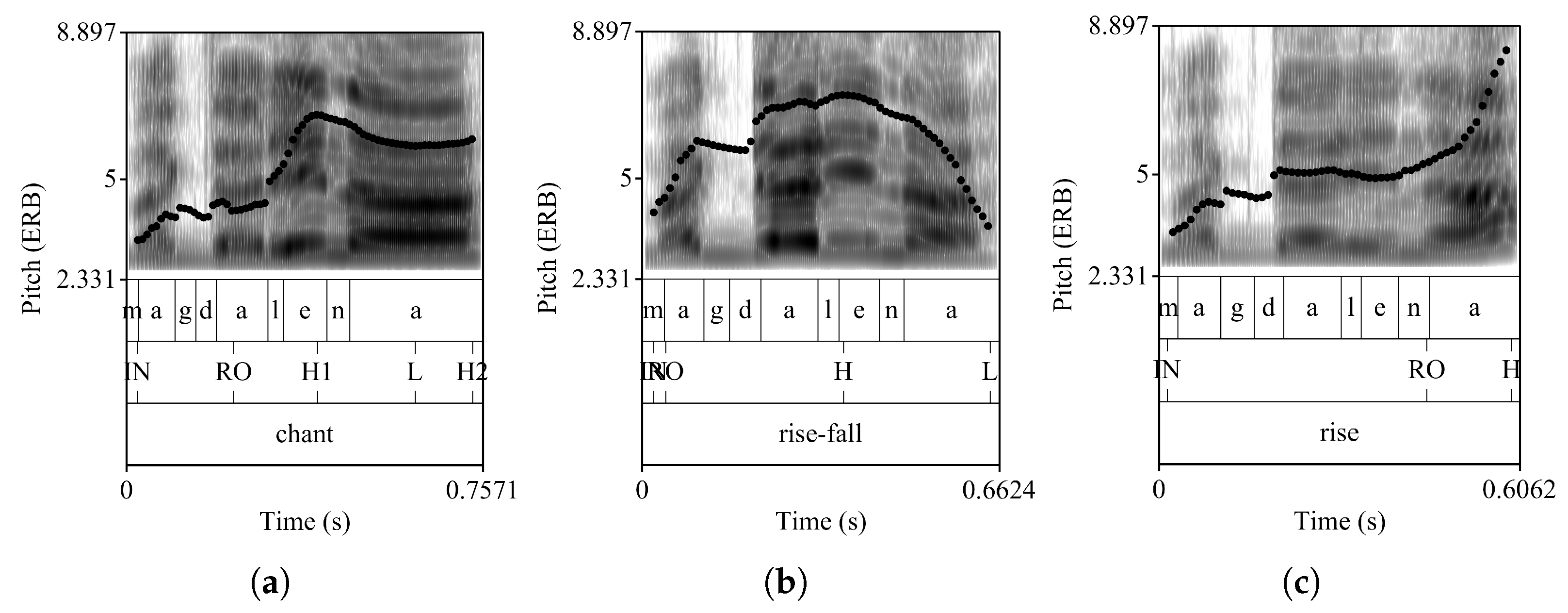

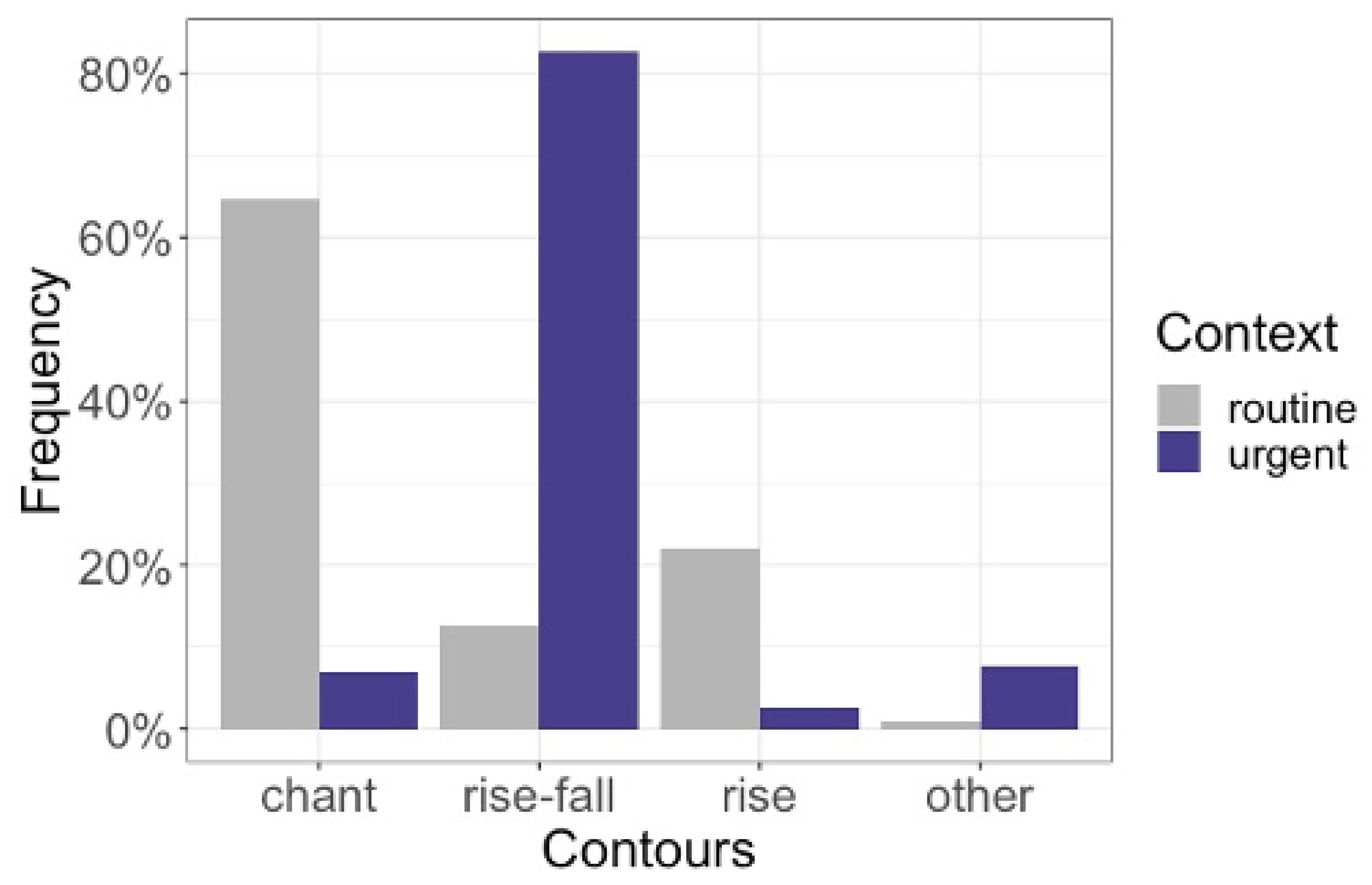


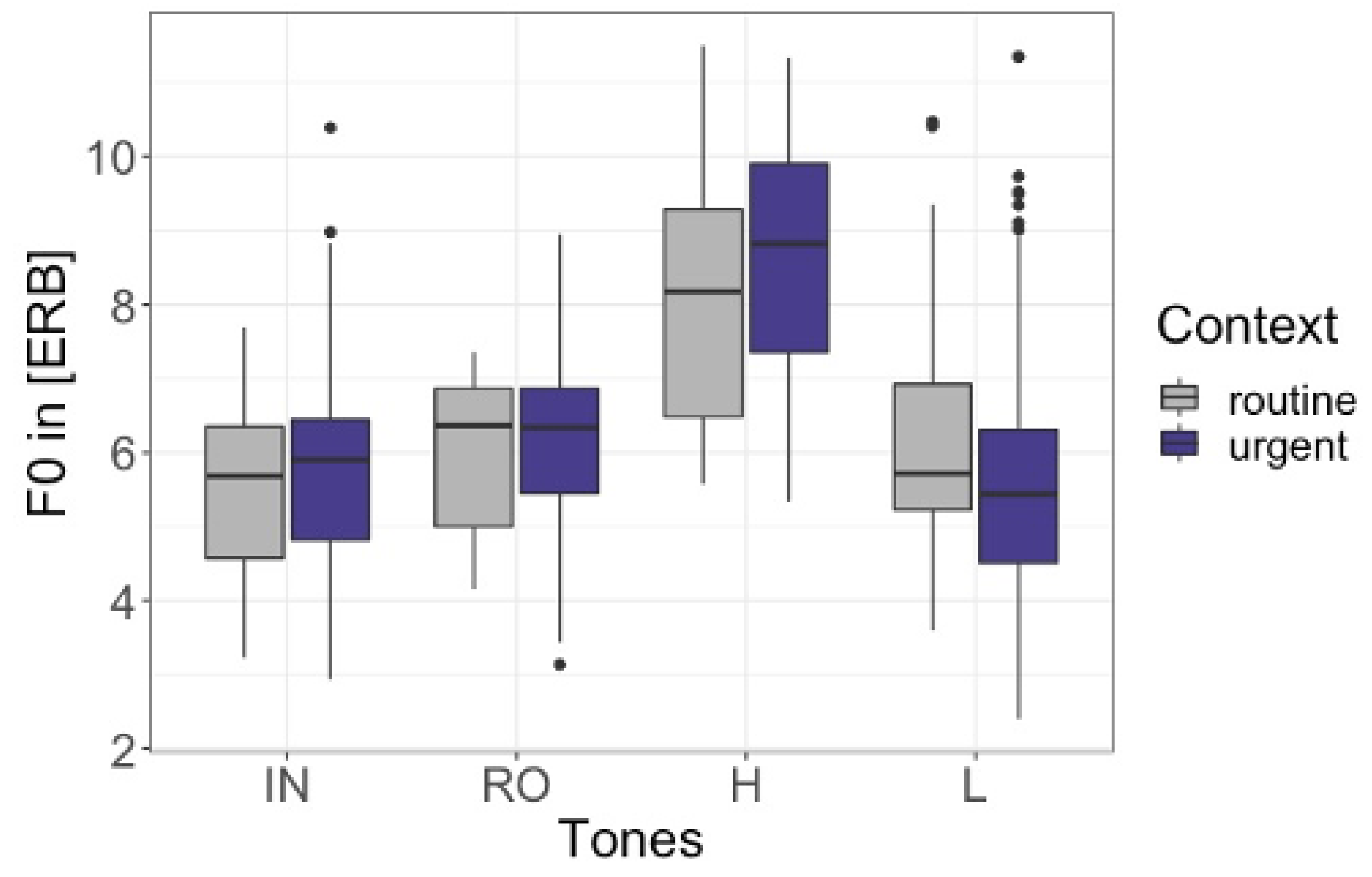

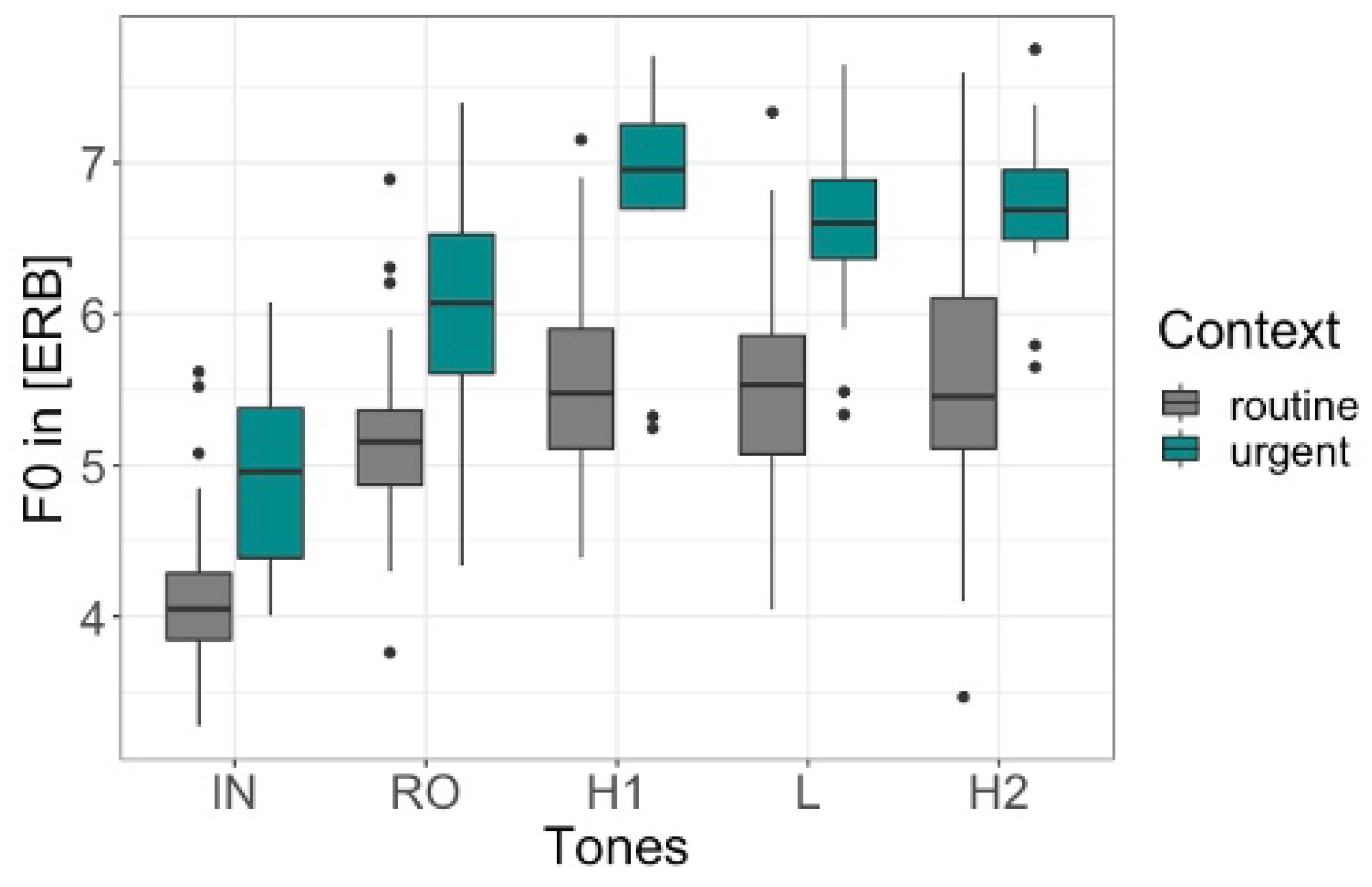
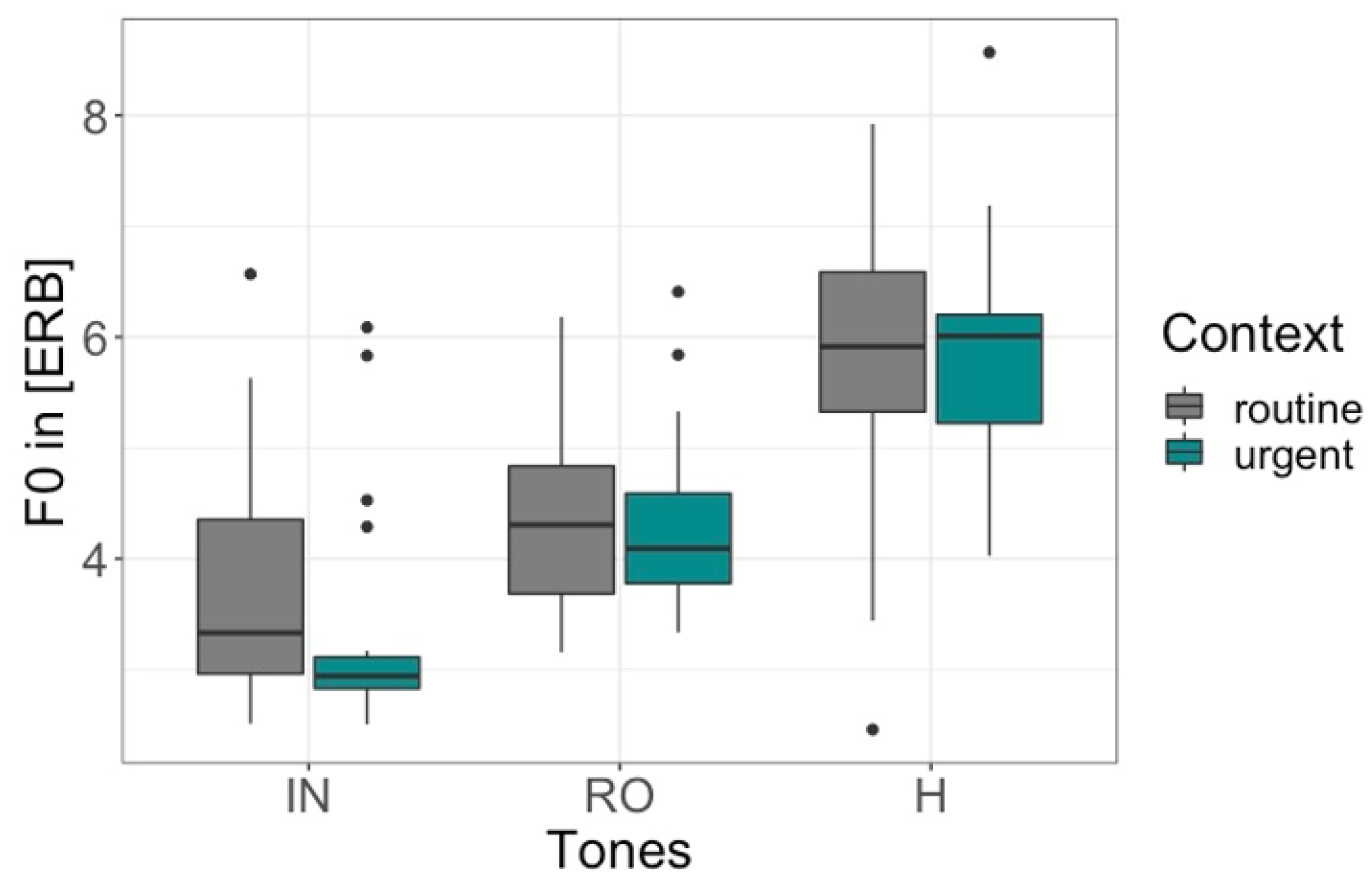
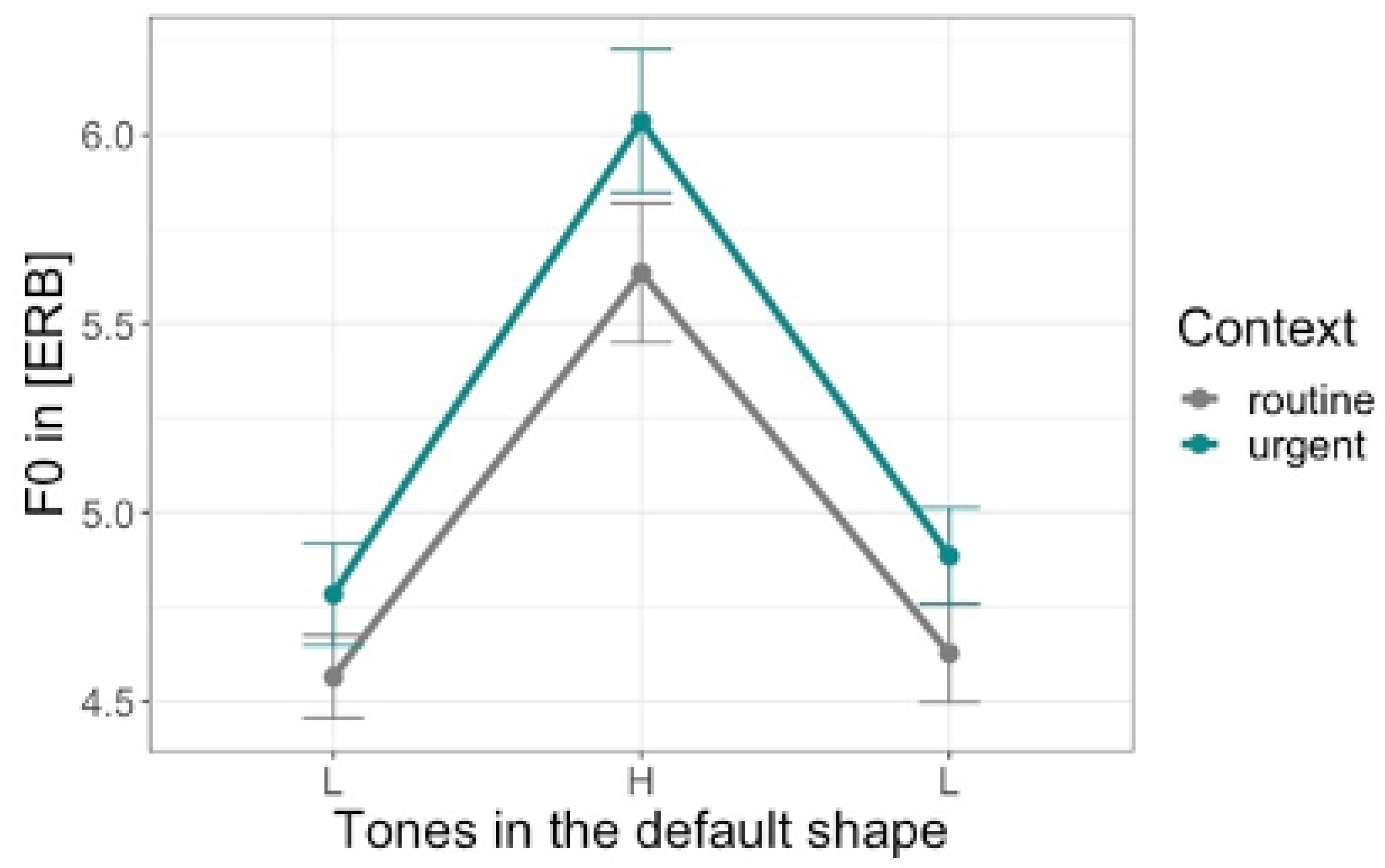
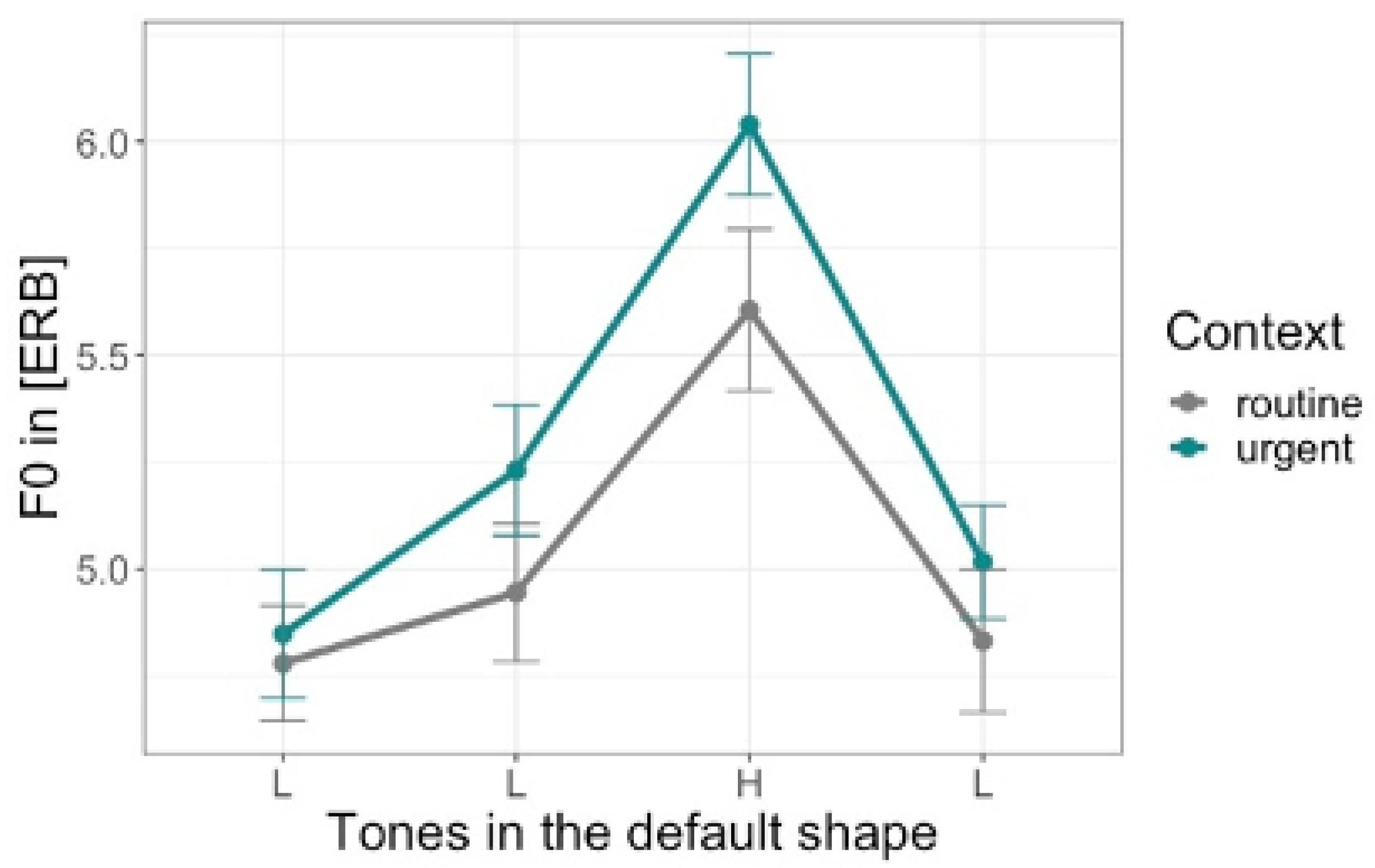
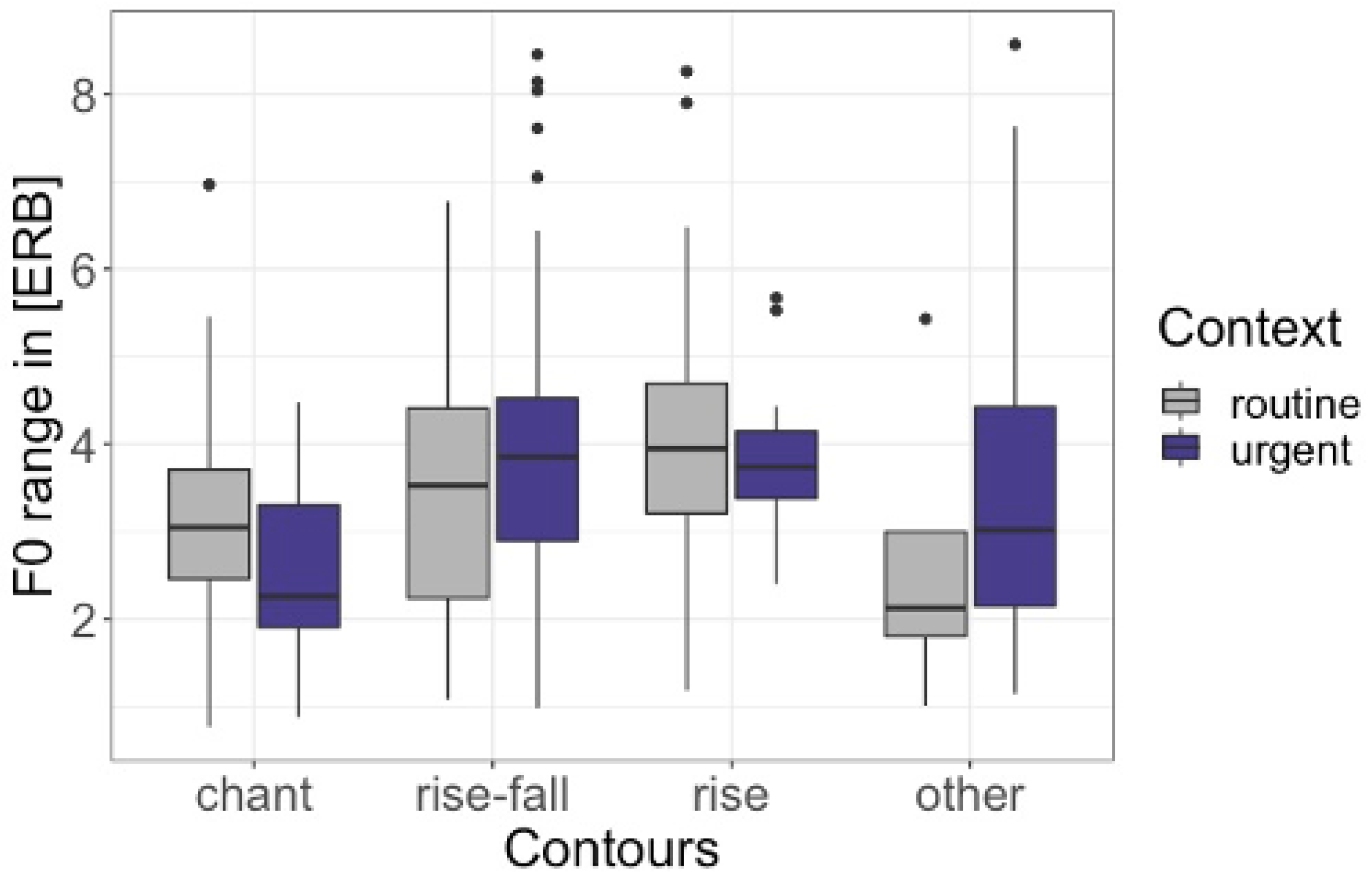
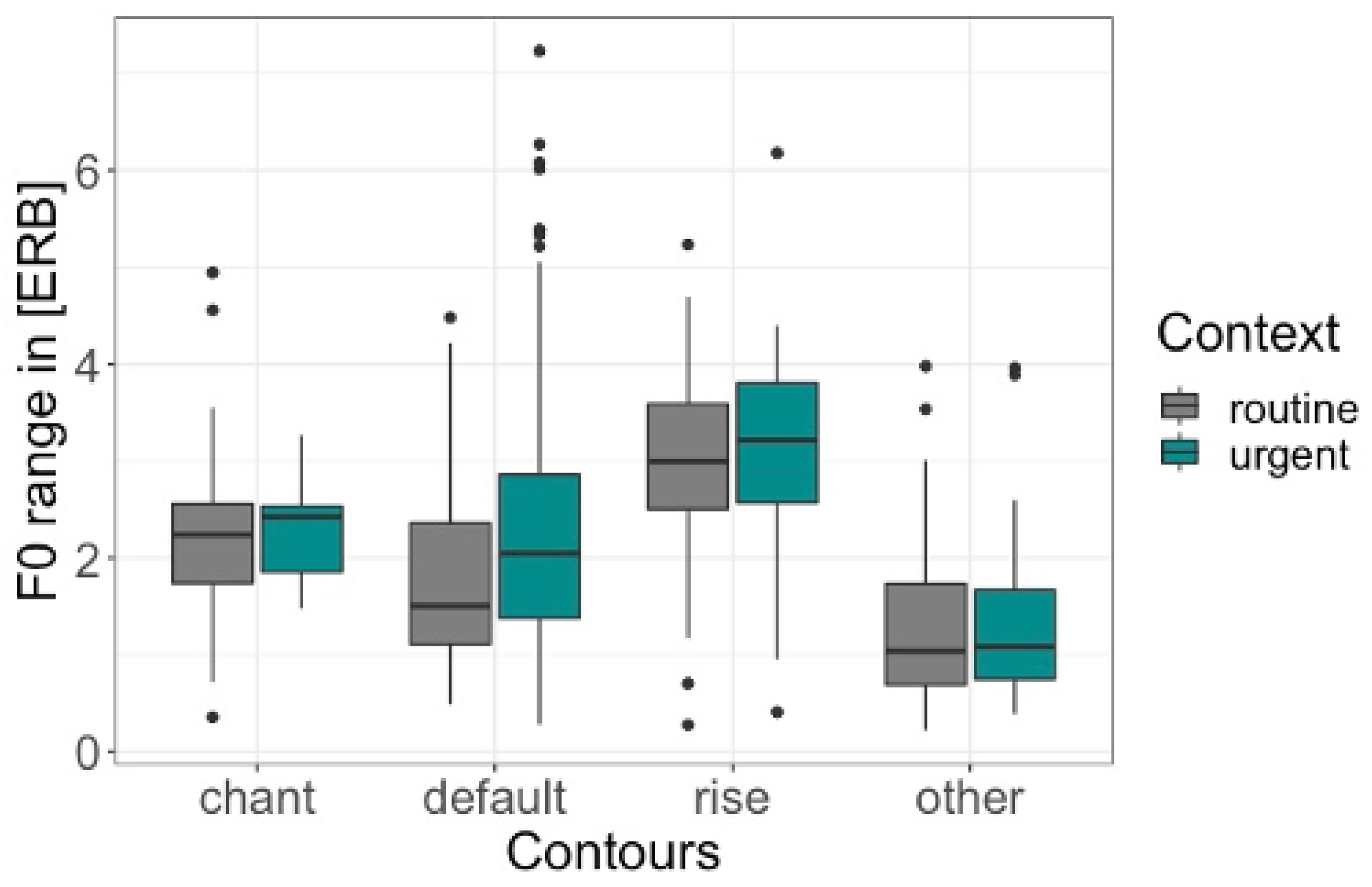
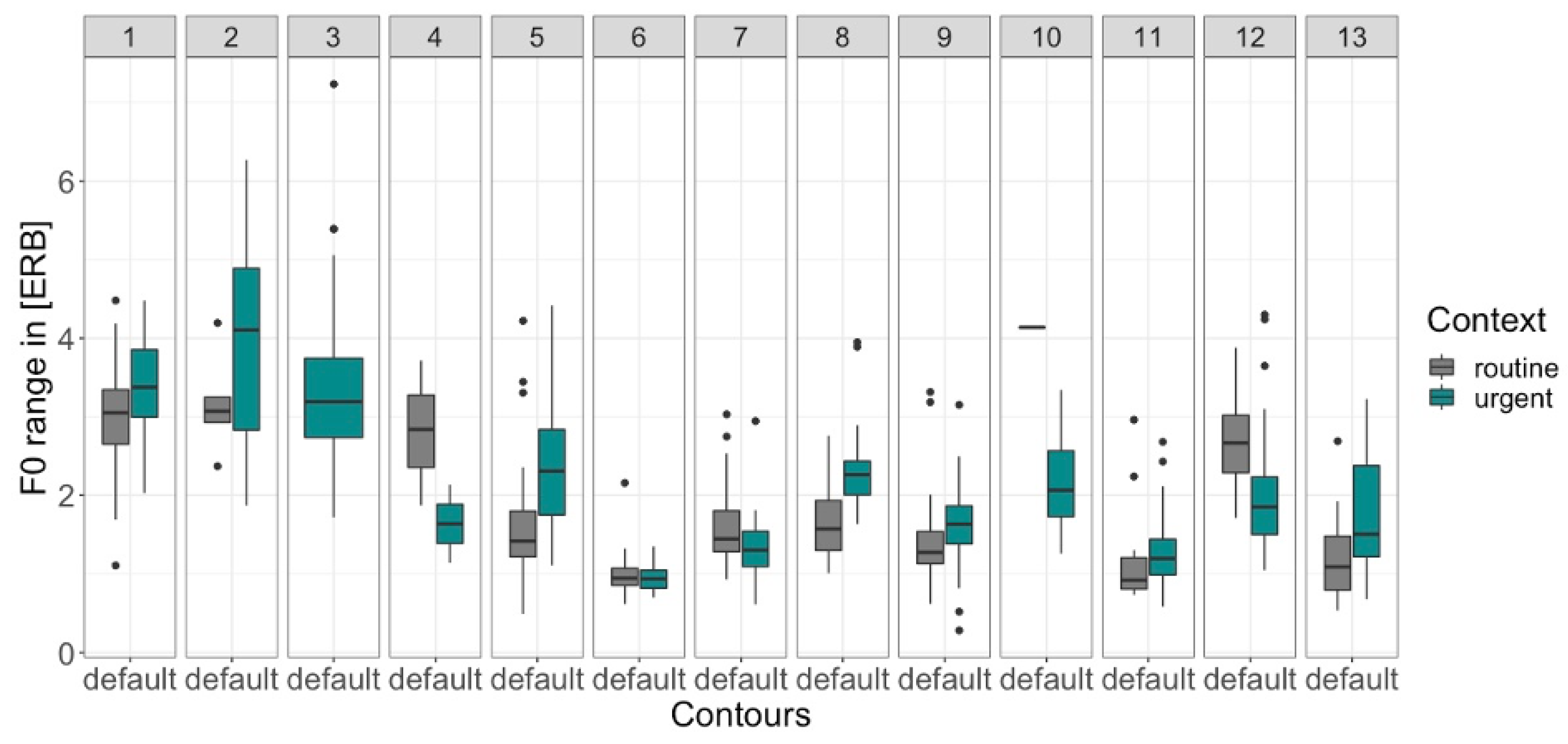


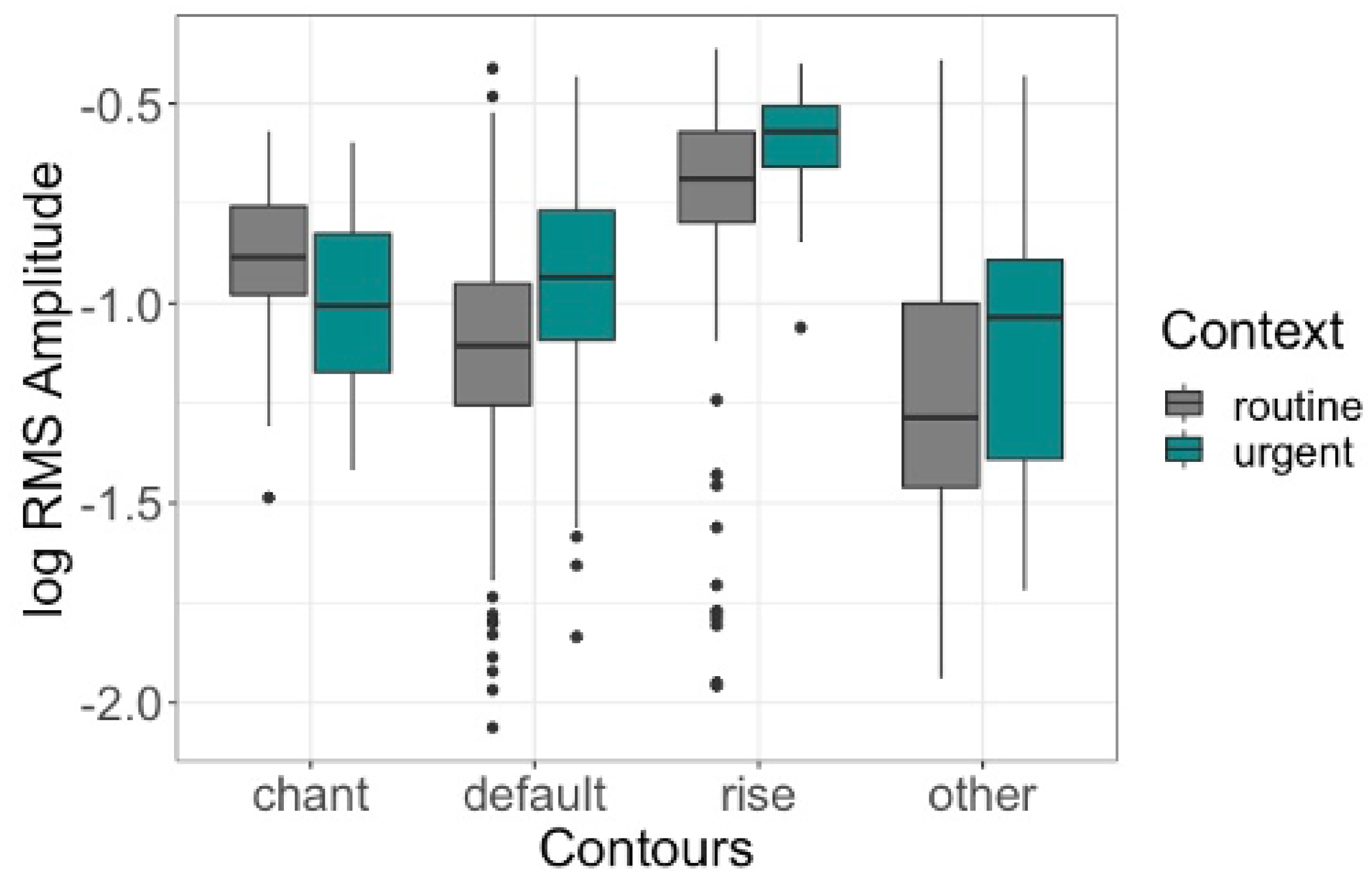

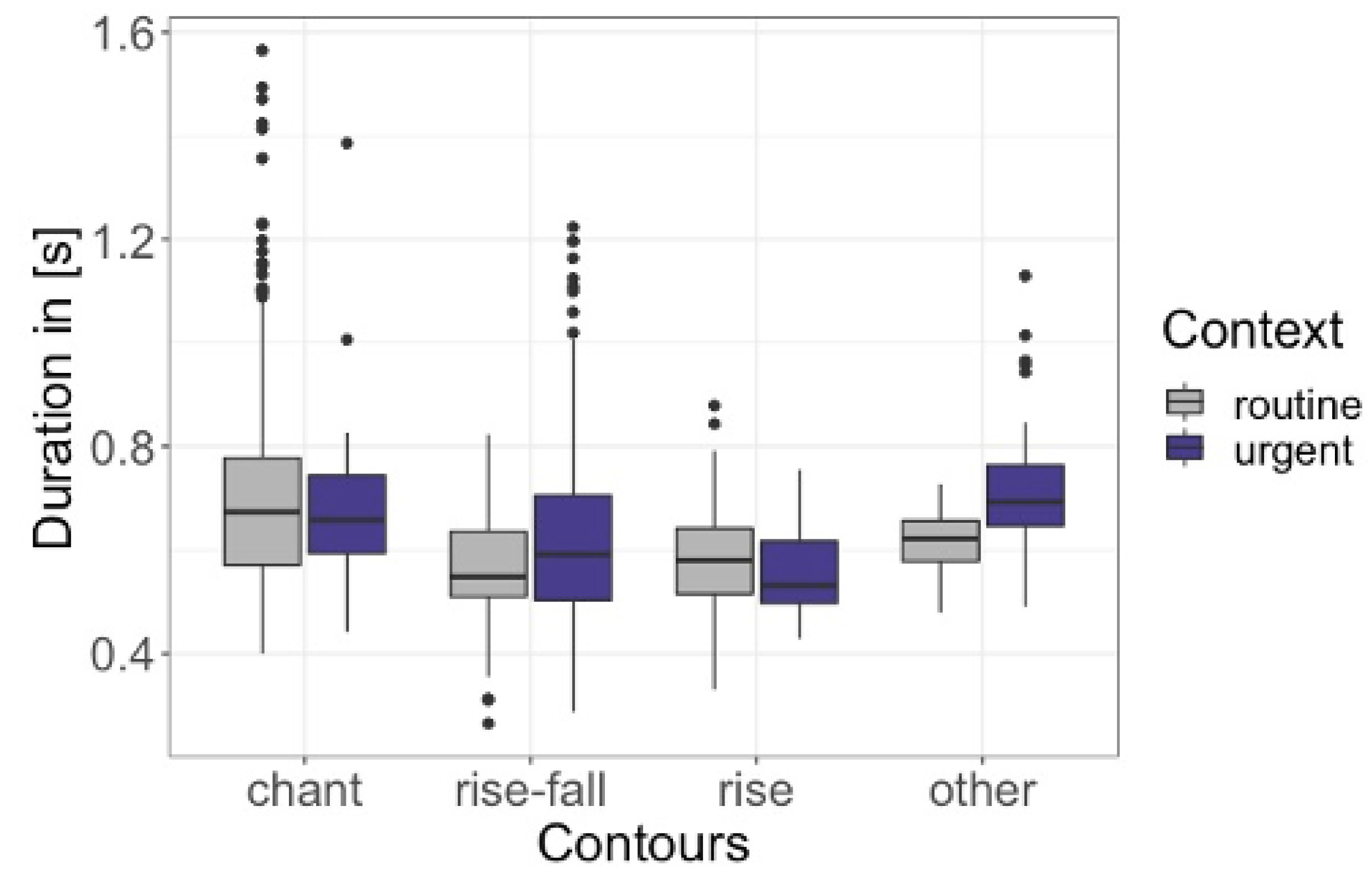
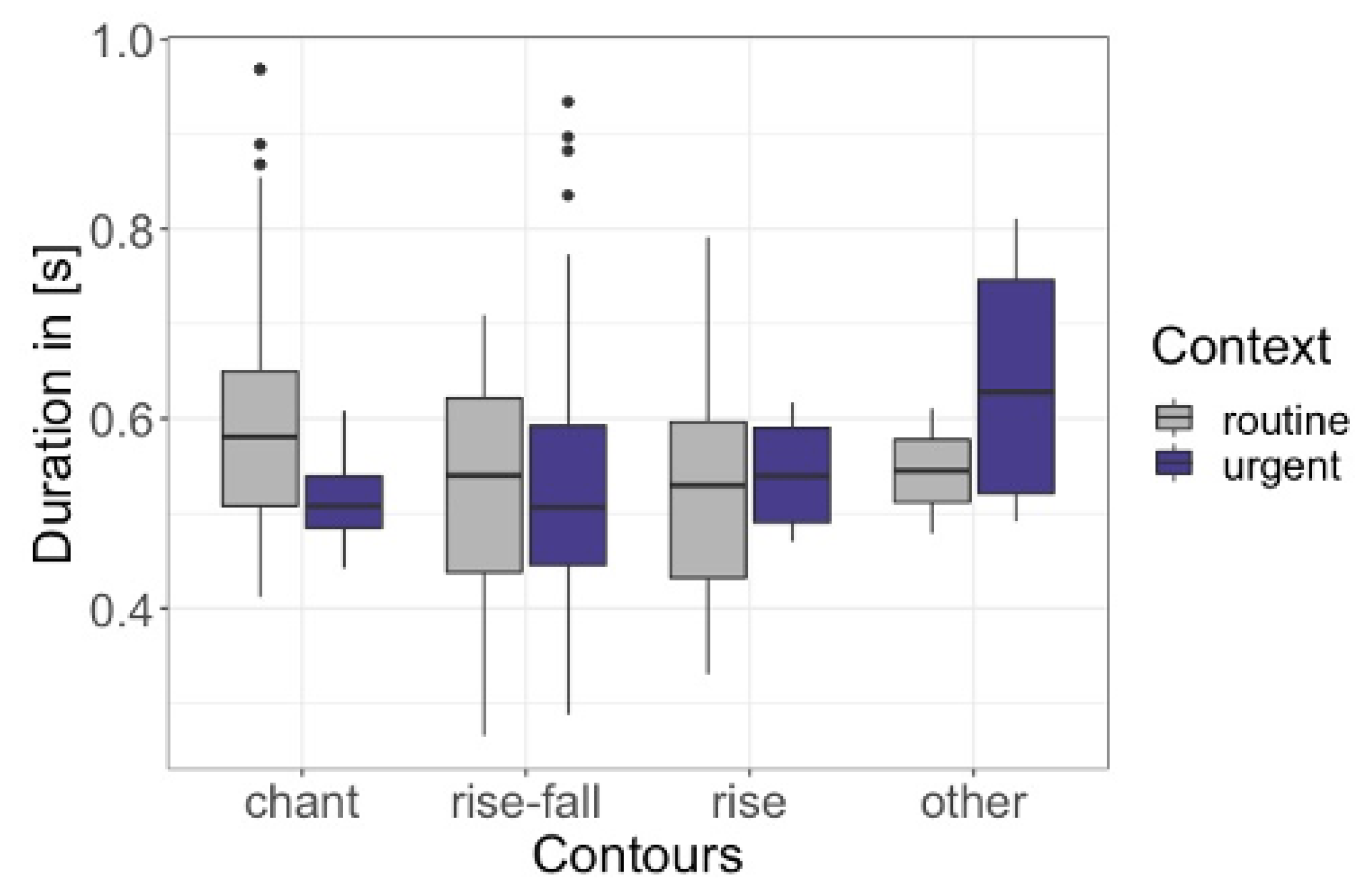
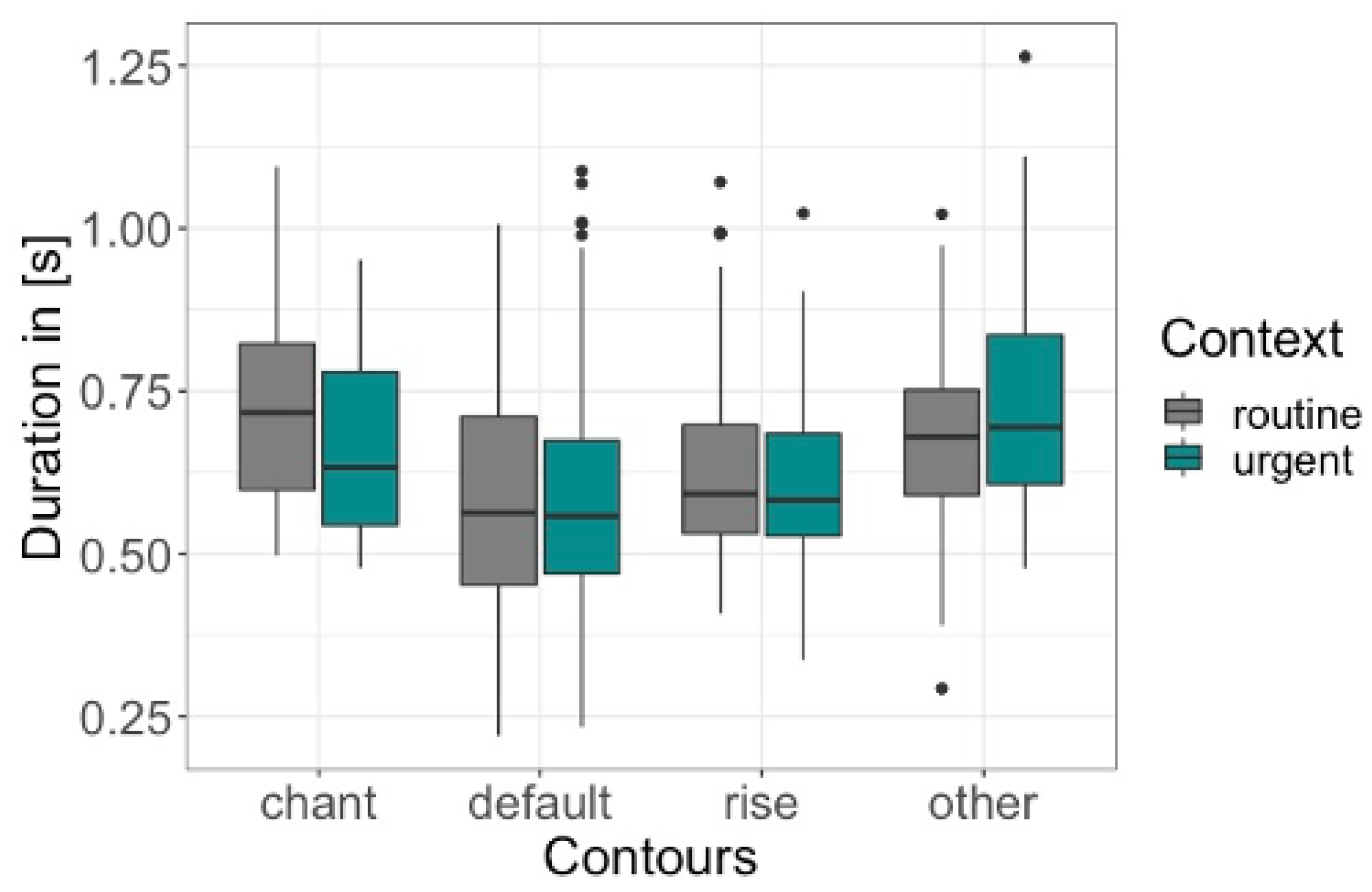
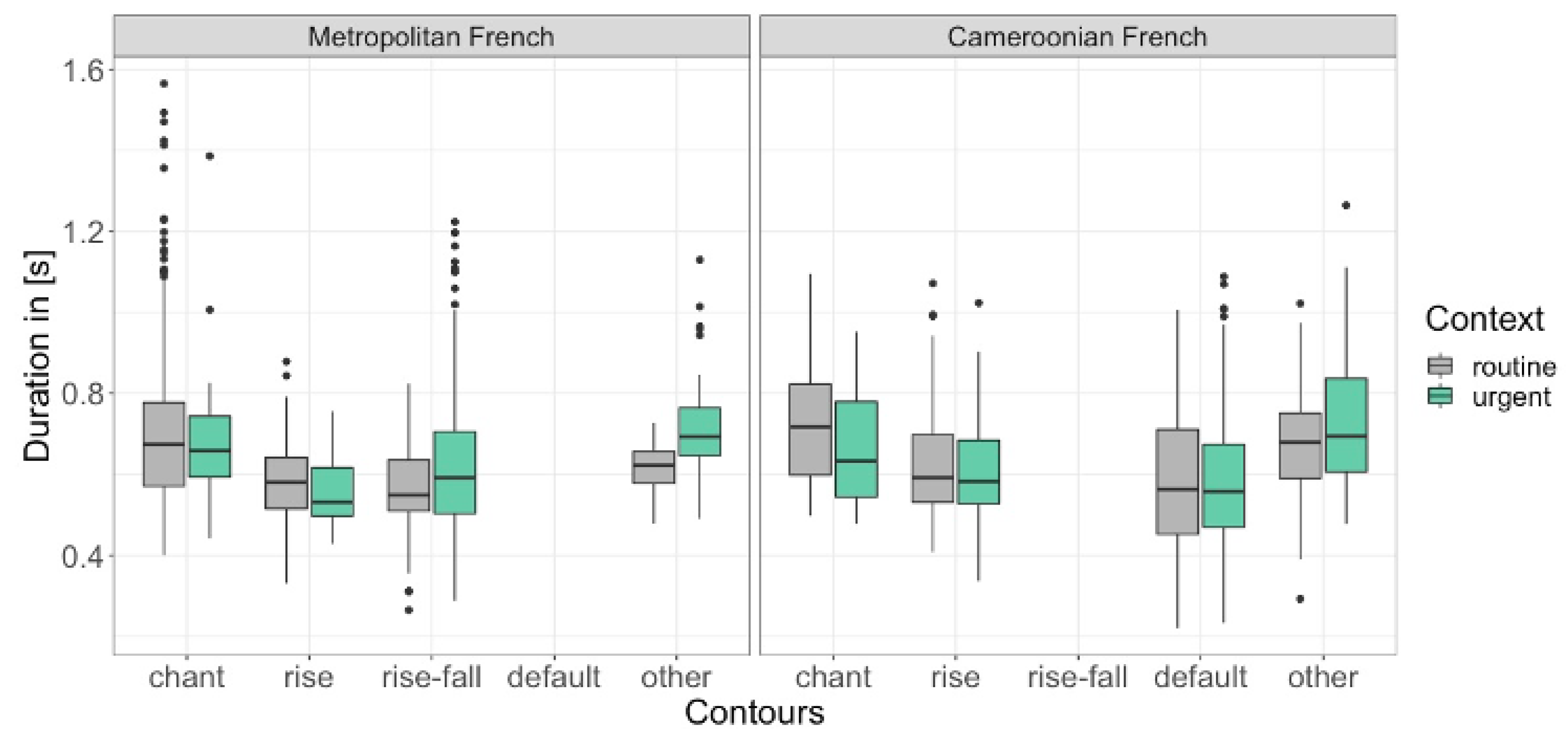
| Syllables | Names | ||
|---|---|---|---|
| 1 | Yann | Louise | Marthe |
| [jan]/[jân] | [lwiz]/[lɥîz] | [maχt]/[mâ:t] | |
| 2 | Daniel | Alice | Patrick |
| [daɲɛl]/[dàɲl] | [alis]/[àlîs] | [patʁik]/[pàtɾîk] | |
| 3 | Natalia | Marina | Grégory |
| [natalja]/[nàtáljà] | [maʁina]/[màɾínà] | [gʁegoʁi]/[gɾégóɾî] | |
| 4 | Magdalena | Alexandra | Bénédictine |
| [magdalena]/[mágdàlénà] | [aleksãdʁa]/[àlègzdɾà] | [benediktin]/[bènèdíktìn] |
| L (L) H L | L (L) HL | H H HL |
|---|---|---|
| Marina | Patrick | Grégory |
| Natalia | Daniel | |
| Alexandra | Alice | |
| Magdalena | Marthe | |
| Louise | ||
| Yann | ||
| Bénédictine |
| Chant | Rise-Fall | Rise | Other | |||||
|---|---|---|---|---|---|---|---|---|
| Routine | Urgent | Routine | Urgent | Routine | Urgent | Routine | Urgent | |
| S1 | 89 (32) | 94.4 (34) | 11 (4) | 5.6 (2) | ||||
| S2 | 69.7 (23) | 24 (8) | 75.8 (25) | 6 (2) | 24 (8) | |||
| S3 | 83.3 (30) | 2.8 (1) | 8.3 (3) | 80.6 (29) | 8.3 (3) | 13.9 (5) | 2.8 (1) | |
| S4 | 30.6 (11) | 22.2 (8) | 75 (27) | 44.4 (16) | 2.8 (1) | 22.2 (8) | ||
| S5 | 83.3 (30) | 11.1 (4) | 97.2 (35) | 5.6 (2) | 2.8 (1) | |||
| S6 | 58.3 (21) | 100 (36) | 41.7 (15) | |||||
| S7 | 25 (9) | 44.4 (16) | 61.1 (22) | 30.6 (11) | 38.9 (14) | |||
| S8 | 83.3 (30) | 22.2 (8) | 2.8 (1) | 75 (27) | 11.1 (4) | 2.8 (1) | 2.8 (1) | |
| S9 | 91.7 (33) | 58.3 (21) | 2.8 (1) | 38.9 (14) | 5.6 (2) | 2.8 (1) | ||
| S10 | 5.6 (2) | 11.1 (4) | 97.2 (35) | 83.3 (30) | 2.8 (1) | |||
| S11 | 44.4 (16) | 5.6 (2) | 16.7 (6) | 86.1 (31) | 36.1 (13) | 5.6 (2) | 2.8 (1) | 2.8 (1) |
| S12 | 72.2 (26) | 2.8 (1) | 25 (9) | 97.2 (35) | 2.8 (1) | |||
| S13 | 77.8 (28) | 2.8 (1) | 100 (36) | 19.4 (7) | ||||
| S14 | 91.7 (33) | 5.6 (2) | 5.6 (2) | 77.8 (28) | 2.8 (1) | 16.7 (6) |
| Chant | Default | Rise | Other | |||||
|---|---|---|---|---|---|---|---|---|
| Routine | Urgent | Routine | Urgent | Routine | Urgent | Routine | Urgent | |
| S1 | 100 (36) | 100 (36) | ||||||
| S2 | 3 (1) | 14 (5) | 75 (27) | 75 (27) | 19 (7) | 8 (3) | 6 (2) | |
| S3 | 36 (13) | 6 (2) | 94 (34) | 64 (23) | ||||
| S4 | 9 (3) | 6 (2) | 79 (27) | 76 (25) | 12 (4) | 18 (6) | ||
| S5 | 6 (2) | 6 (2) | 91 (32) | 85 (28) | 3 (1) | 9 (3) | ||
| S6 | 97 (35) | 100 (36) | 3 (1) | |||||
| S7 | 6 (2) | 82 (27) | 87 (27) | 12 (4) | 13 (4) | |||
| S8 | 3 (1) | 94 (34) | 97 (35) | 6 (2) | ||||
| S9 | 97 (35) | 97 (34) | 3 (1) | 3 (1) | ||||
| S10 | 81(29) | 3 (1) | 97 (35) | 14 (5) | 3 (1) | 3 (1) | ||
| S11 | 31 (11) | 53 (19) | 6 (2) | 64 (23) | 47 (17) | |||
| S12 | 22 (8) | 8 (3) | 67 (24) | 86 (31) | 6 (2) | 3 (1) | 6 (2) | 3 (1) |
| S13 | 3 (1) | 11 (4) | 61 (22) | 72 (26) | 22 (8) | 14 (5) | 17 (6) |
Publisher’s Note: MDPI stays neutral with regard to jurisdictional claims in published maps and institutional affiliations. |
© 2022 by the authors. Licensee MDPI, Basel, Switzerland. This article is an open access article distributed under the terms and conditions of the Creative Commons Attribution (CC BY) license (https://creativecommons.org/licenses/by/4.0/).
Share and Cite
Hamlaoui, F.; Żygis, M.; Engelmann, J.; Quiroz, S.I. Prosodic Transfer in Contact Varieties: Vocative Calls in Metropolitan and Basaá-Cameroonian French. Languages 2022, 7, 285. https://doi.org/10.3390/languages7040285
Hamlaoui F, Żygis M, Engelmann J, Quiroz SI. Prosodic Transfer in Contact Varieties: Vocative Calls in Metropolitan and Basaá-Cameroonian French. Languages. 2022; 7(4):285. https://doi.org/10.3390/languages7040285
Chicago/Turabian StyleHamlaoui, Fatima, Marzena Żygis, Jonas Engelmann, and Sergio I. Quiroz. 2022. "Prosodic Transfer in Contact Varieties: Vocative Calls in Metropolitan and Basaá-Cameroonian French" Languages 7, no. 4: 285. https://doi.org/10.3390/languages7040285
APA StyleHamlaoui, F., Żygis, M., Engelmann, J., & Quiroz, S. I. (2022). Prosodic Transfer in Contact Varieties: Vocative Calls in Metropolitan and Basaá-Cameroonian French. Languages, 7(4), 285. https://doi.org/10.3390/languages7040285






